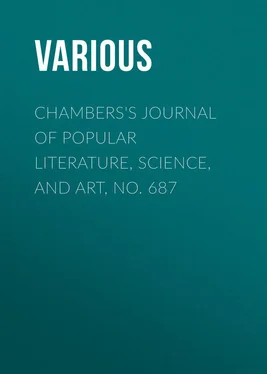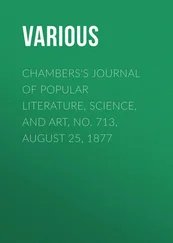Various - Chambers's Journal of Popular Literature, Science, and Art, No. 687
Здесь есть возможность читать онлайн «Various - Chambers's Journal of Popular Literature, Science, and Art, No. 687» — ознакомительный отрывок электронной книги совершенно бесплатно, а после прочтения отрывка купить полную версию. В некоторых случаях можно слушать аудио, скачать через торрент в формате fb2 и присутствует краткое содержание. Издательство: Иностранный паблик, Жанр: periodic, foreign_edu, на английском языке. Описание произведения, (предисловие) а так же отзывы посетителей доступны на портале библиотеки ЛибКат.
- Название:Chambers's Journal of Popular Literature, Science, and Art, No. 687
- Автор:
- Издательство:Иностранный паблик
- Жанр:
- Год:неизвестен
- ISBN:нет данных
- Рейтинг книги:4 / 5. Голосов: 1
-
Избранное:Добавить в избранное
- Отзывы:
-
Ваша оценка:
- 80
- 1
- 2
- 3
- 4
- 5
Chambers's Journal of Popular Literature, Science, and Art, No. 687: краткое содержание, описание и аннотация
Предлагаем к чтению аннотацию, описание, краткое содержание или предисловие (зависит от того, что написал сам автор книги «Chambers's Journal of Popular Literature, Science, and Art, No. 687»). Если вы не нашли необходимую информацию о книге — напишите в комментариях, мы постараемся отыскать её.
Chambers's Journal of Popular Literature, Science, and Art, No. 687 — читать онлайн ознакомительный отрывок
Ниже представлен текст книги, разбитый по страницам. Система сохранения места последней прочитанной страницы, позволяет с удобством читать онлайн бесплатно книгу «Chambers's Journal of Popular Literature, Science, and Art, No. 687», без необходимости каждый раз заново искать на чём Вы остановились. Поставьте закладку, и сможете в любой момент перейти на страницу, на которой закончили чтение.
Интервал:
Закладка:
Various
Chambers's Journal of Popular Literature, Science, and Art, No. 687 / February 24, 1877
TO LIVE TO A HUNDRED
That is what most people would like, if it could be easily managed. All know that they must throw off 'this mortal coil' some time, but there are innumerable and plausible reasons why they wish to avoid throwing it off as long as possible. They have important affairs on hand which require attention. They have children to educate and see out into the world. They are interested in certain public movements with which the newspapers are rife, and would like to see how these stirring events terminate. They are engaged in some important scientific investigations which they are anxious to complete. They have realised a small fortune, and would like to see it grow something larger, so that they might make a decent flourish with their bequests. And so on without end. They have often declared that the weather has become so bad that life is not worth having. But on second thoughts, when things are looking serious, they come to the conclusion that the weather may be endured, and that the world is not such a bad world after all. Dying, who speaks of dying? The idea of such a thing is ridiculous.
There is a clever book of old date full of pictorial illustrations called the Dance of Death . Each picture represents a pleasant scene in social life, into which Death, in the form of a skeleton, impertinently intrudes himself, and beckons a particular individual to come away; which individual, considerably surprised and disgusted at the summons, is obliged to go off, very much against his will. The moral suggested is the total unexpectedness of the visit – the uncertainty of human life. Such books amuse people. They laugh at seeing a self-complacent person sitting at a table stuffing and enjoying himself with good things, and who, on chancing to look a little aside, perceives to his consternation a skeleton bowing respectfully, and beckoning with its bony finger to walk off. He is wanted, and must march – not a moment to stay. The very glass just poured out must be left untasted. Very droll, very suggestive such pictures, only nobody is ever benefited by them. 'All men think all men mortal but themselves,' says the poet. Men perhaps do not exactly think so. But what comes pretty much to the same thing, they flatter themselves they will have a 'long day.' No doubt they will live a good while yet, and it is as well to be jolly in the meantime.
It is a curious fact, disclosed by physiologists who think deeply on the subject, that society is very much to blame for the comparative shortness of life. This was not well understood when the Dance of Death was written. It is understood now. Inquiries into the laws of health and disease, along with statistics, make it plain that premature decease is owing to a variety of preventable causes. We are gravely informed by Dr Farr, in his letter 1 1 This letter is appended to the Supplement to the Thirty-fifth Annual Report concerning Births, Deaths, and Marriages in England, 1875.
to the Registrar-general of England, that the natural lifetime of man is a century! To die earlier than a hundred years of age is all a mistake. It is the fault of something or somebody or other that people die young. With a good constitution to start with, and due care in ordinary circumstances, life may be protracted to eighty, to ninety, or to a hundred. If that be what most people like, why don't they try? It is very certain, as is observable by the newspaper obituaries, that latterly many persons, whether they have tried or not, lived to be upwards of a hundred years of age. We have just seen a death reported at a hundred and six, and a month or two ago one at a hundred and ten. Some of these long-lived individuals were of a humble rank in life. One or two were parish paupers. Occasionally we hear of negroes in the United States dying at a hundred and ten or a hundred and twelve years old, whose early life was spent in slavery. Among the aristocracy, deaths are pretty frequently reported at about eighty or ninety, but rarely at a hundred and above it. From these circumstances it may be inferred that fine living does not particularly contribute to extreme longevity.
The number of children who die young is immense. Bad nursing, neglect, whooping-cough, croup, measles, scarlet fever, small-pox, dosing with soporifics, carry off a large proportion. Bad air in close stuffy dwellings, and insufficient food, likewise destroy great numbers of children, particularly in old ill-contrived towns. Only by a kind of good-luck and natural strength of fibre do they get beyond five years of age. That is the first clearance; after which ensue the casualties of youth, too often brought about by carelessness. Latterly, Death has played great havoc among young and old through new developments of what are called zymotic diseases; or in plain English, diseases which originate in the fermentation of putrefying substances. These diseases are by no means new. They were known in ancient times. But in our own day they have sprung into enormous vigour, through the influence of modern domestic arrangements; and generally speaking, the finer the houses the worse have matters grown.
In his operations, Death has wonderfully potent auxiliaries in house-builders; or at least those who get up houses to sell regardless of sanitary arrangements. Pipes to carry off refuse are scamped, everything is scamped. The pipes are ill put together and badly laid; foul air, the result of festering fermentation, escapes into the dwelling. Diphtheria and typhoid fever are the probable consequence. Much that is curious has been written concerning these zymotic diseases. It is now generally believed that the poisonous gases arising from imperfect pipeage in houses consist intrinsically of fungoid germs, which are unconsciously swallowed by the luckless inhabitants of the houses so affected. Whether this Germ theory be correct or not, the result is the same. By inhaling the vitiated air, we drink a kind of poison, which produces the most fatal disorders. In our own small way, we could speak from experience of this bad pipeage system, which has obviously become one of the scandals of the age. It is enough for us to advise every purchaser of a house to look strictly to the condition of pipes and drains. If he cannot do it himself, let him procure the assistance of experts. What a thing to say of some modern improvements, that they have ended in giving us two of the greatest evils in life – foul air in our houses, and foul water to drink! One would almost think that these so-called improvements had been ingeniously devised in the interest of the undertakers.
People as we see are slain right and left by ailments which seize upon them insidiously when least expected. The weakest of course come off worst. This brings us to the fact that considerable numbers possess but a feeble stamina, and are unable to ward off disease, even with all the appliances of art. They come of a weakly parentage perhaps through several generations. Being by inheritance little better than an incarnation of beer and gin, they are absolutely born with a tendency to succumb to disorders which others would escape. Dr Farr makes the remark, that our very philanthropic schemes for rendering succour to the afflicted tend to raise crops of people of inferior organisation. 'The imbecile, the drunkard, the lunatic, the criminal, the idle, and all tainted natures, were once allowed to perish in fields, asylums, or jails, if they were not directly put to death; but these classes and their offspring now figure in large numbers in the population.'
From one cause and another, it is not surprising that so comparatively few reach extreme old age. The average of human life has been extended through the resources of modern science, but not to such an extent as might be expected, for the average still does not range higher than forty-five to fifty. Some reasons for this comparatively low average have been alluded to. To these may be added the frightful deterioration of health from intemperance. Drinking, once a fashionable vice, has become a prevalent evil in the lower departments of society, and the evil is conspicuously increased in proportion to an advancement in the gains of labour. Alcohol! In that single word we have no end of premature deaths accounted for. The most correctly logical definition, as far as we have seen, of the physical and mental ills inflicted through the agency of alcohol, is that given by Dr B. W. Richardson in his work on the
Читать дальшеИнтервал:
Закладка:
Похожие книги на «Chambers's Journal of Popular Literature, Science, and Art, No. 687»
Представляем Вашему вниманию похожие книги на «Chambers's Journal of Popular Literature, Science, and Art, No. 687» списком для выбора. Мы отобрали схожую по названию и смыслу литературу в надежде предоставить читателям больше вариантов отыскать новые, интересные, ещё непрочитанные произведения.
Обсуждение, отзывы о книге «Chambers's Journal of Popular Literature, Science, and Art, No. 687» и просто собственные мнения читателей. Оставьте ваши комментарии, напишите, что Вы думаете о произведении, его смысле или главных героях. Укажите что конкретно понравилось, а что нет, и почему Вы так считаете.







